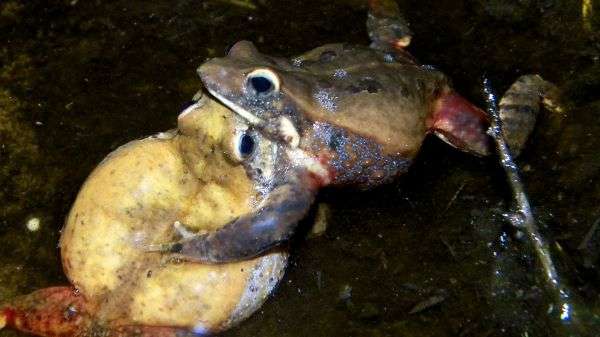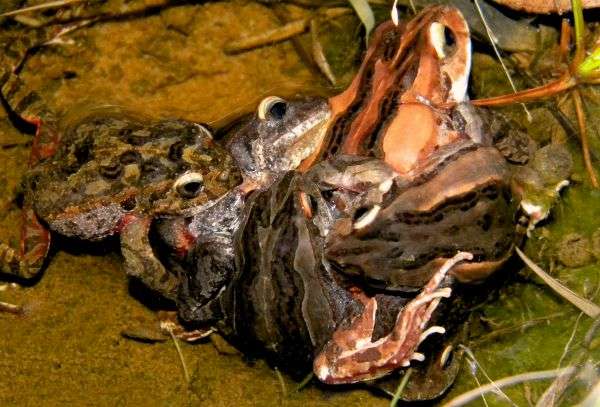Frogs pit guns against sperm in battle for mates

Males competing for female attention is nothing new but research into frogs in swamps near Albany has revealed something unusual—larger, stronger-armed males fare better fathering offspring in isolation while smaller, weaker males are more successful in a group.
The mating habits of the Australian quacking frog (Crinia georgiana), a species known for its intense wrestling matches between males were studied by UWA evolutionary biologist Bruno Buzatto.
When quacking frogs mate, one or more males grab hold of the female with their strong front legs in a move known as an amplexus, and grapple to be in the best position when the female releases her eggs into the water.
He found frogs with strong arms are most successful at mating where there is a low density of males, because they are able to fight off competitors and get the females to themselves.
But, where there is a high density of males, multiple–male matings are almost inevitable and sperm competition plays a much bigger role in determining which frogs ultimately pass on their genes.
"As soon as the numbers go up…you see more fights but at the same time the whole system becomes so chaotic," Dr Buzatto says.
"There's so many males around that it's almost unavoidable for the big guys to get involved in these multi-male amplexus'.
"In the end the small little guys start doing much better, they start being able to mate way more frequently in higher densities than in lower densities."

It was already known that the male frogs have much stronger forearms than females and he wanted to understand the evolution of those thick arms, Dr Buzatto says.
The researchers observed the frogs during the 2013 and 2014 breeding seasons at three sites in Albany, one site about 10km west of Denmark and one site about 30km south-east of Perth.
They measured the body size and arm girth of 439 male frogs, and recorded their mating success in the field.
The research's next stage is to test the paternity of eggs collected after matings to find out if frogs with smaller arms invest in higher sperm quality in order to pass on their genes, Dr Buzatto says.
"There is data on the size of their testes and one thing we do know is that in high population densities frogs invest more in testes," he says.
"They usually have smaller arms and larger testes."
More information: Bruno A. Buzatto et al. Sperm competition and the evolution of precopulatory weapons: Increasing male density promotes sperm competition and reduces selection on arm strength in a chorusing frog, Evolution (2015). DOI: 10.1111/evo.12766
Journal information: Evolution
Provided by Science Network WA
This article first appeared on ScienceNetwork Western Australia a science news website based at Scitech.




















